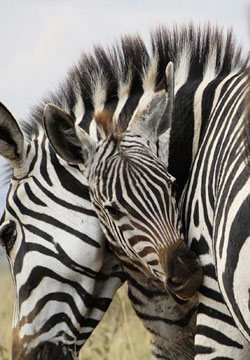THE PREDATOR ATTACK: Blame it on the Lion?
October 16, 2013
In 2003, the worst kind of slaughter of the wild saw Nairobi National Park jungle left with only 9 kings! 11 lions were brutally killed during the wet season after the community could no longer watch helplessly as the lions day in day out feasted on their most prized possessions – Livestock. The Consolation Program which has been managed by both The Wildlife Foundation and Friends of Nairobi National Park was initiated as an emergency measure to keep the retaliation attacks by the community in check. The program and other conservation initiative by the Kenya Wildlife Service has seen the lion population in Nairobi National Park grow to over 40 individuals as identified by lion researchers Michael Mbithi and David Mascall in their June 2011 Nairobi National Park Lion ID database. The Mbithi-Mascall identified each individual lion using 6 special features on each lion; Whisker spots, Ear tears, Mane development, Missing tail tuft, Broken teeth and large injuries, and Nose spotting.
While the lion population has experienced retaliation from time to time especially when there is no funding for the Consolation program, the other predators – leopard, hyena, crocodile, wild dogs and cheetah – hardly get to experience the wrath of livestock owners who lose their livestock as prey. The lion has been targeted one occasion too many that Predation has synonymously been referred to as Lion Kills. That could be true in the case of the Lion where it is the most endangered and likely to get killed in the case of retaliation for a predation. But in the case of livestock, predation is by more than just the lion. All predators are responsible for livestock kills.
If there is more than just lion kills, why is the lion the easiest target for retaliation?
I spoke to Nickson Parmisa, a conservationist by passion and a local chief living in Triangle One (i.e. the open land south of Nairobi National Park that is closest to the Park and experiences most predation because of its close proximity). Nickson explains the behavior of the lion vis-à-vis that of other predators that makes it an easy retaliation target.
“First, it is important to understand that each of the three triangles in the dispersal range of Nairobi National Park wildlife experiences different predators. Lions mostly attack in Triangle 1 (also known as Kitengela). Triangle 2 (also known as Isinya), which is to the East of Kitengela gets most attacks by Leopards and Cheetahs, while the most common predator in Triangle 3 (also known as Kipeto and is to the West of Kitengela) is the wild dog.”
Nickson explains that Lions are at a disadvantage because of their behavior. “Lions hang around after a kill while most of the other predators disperse immediately and are not easily traceable. Lions also walk in a big group and that’s why you will find more than one has been killed in a retaliation attack.”
Not every predation case is a lion kill. The Kenya Wildlife Service Patrol team, The Wildlife Foundation scouts and livestock owners are able to identify the predator responsible through a thorough verification process that is called tracking.
The Consolation Program compliments the Wildlife Conservation Lease Program by ensuring that the wildlife protected in these dispersal area co-exist with the landowners with minimal human-conflict. The landowners who lose their livestock to predation get a small consolation payment to ease their fury and in turn they rarely retaliate and they tolerate the predators and even protect them when they are in danger. On several occasions, the community will drive stray animals back into the park when they know it is dangerous for them to be out of the park. One such incidence was when a stray rhino wandered out of the park into the Kitengela area and the community members gently drove it back into the park. With increased cases of poaching in the country, the only safe place for a rhino to be in is the park and as much as the dispersal area is open and safe for other wildlife, the community understands that wildlife such as rhinos cannot thrive in the dispersal area as they may attract an influx of poachers in the area which also puts the other wildlife and their livestock at risk. When a poacher misses his target, he doesn’t go home empty handed, he finds an alternative.



Leave a Reply